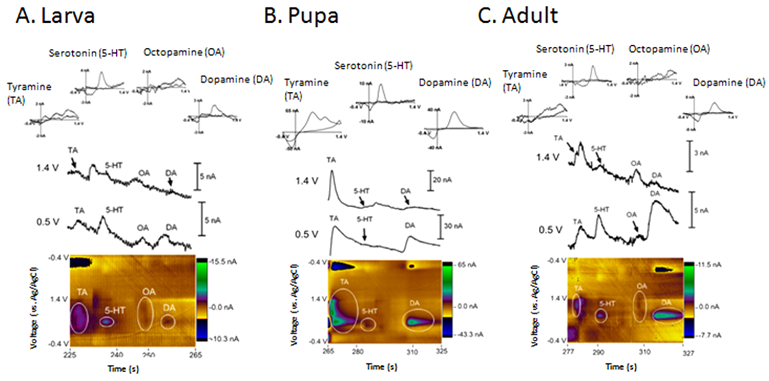Drosophila Neurotransmitters Analysis Service
Communication between neurons relies heavily on chemical synapses, i.e., synaptic vesicles containing various neurotransmitters. This chemical information is transmitted over a longer period of time and over a wider space, making it difficult to detect in real time by electrophysiological methods.
Drosophila is a model organism for studying neurotransmitter-regulated pathways and relies on the construction of flexible and robust transgenic reporter systems. Appropriate and effective assays can help capture the neurotransmitters that are lowly expressed and reveal the release and regulation processes.
CD BioSciences relies on powerful separation (chromatography, microdialysis, capillary electrophoresis, etc.) and detection (mass spectrometry and electrochemistry) platforms to provide sensitive, high spatial and temporal specificity, and high-throughput assays for neurotransmitters including dopamine, octopamine, tyramine, 5-hydroxytryptamine, glutamate, GABA and acetylcholine, etc. We are committed to optimizing neurotransmitter assays for Drosophila and providing the fastest, cutting-edge total solution to our customers worldwide.

Fig.1 Detection of neurotransmitters in Drosophila by electrochemical method (Denno et al. 2015)
Our Service
-
Isolation of Neurotransmitters
Neurotransmitters are very rich in variety, are small molecules, and have very low concentrations. Therefore, separation methods are particularly important for the detection of neurotransmitters. CD BioSciences provides gas chromatography (GC), high performance liquid chromatography (HPLC), microdialysis and capillary electrophoresis (CE) methods for the separation of neurotransmitters from the brain or central nervous system of Drosophila for subsequent assay analysis.
- GC and HPLC are well-established tools for the separation and analysis of tissue samples, and can efficiently separate all kinds of neurotransmitters from homogenates.
- CE is suitable for small sample sizes in species such as Drosophila, and can separate neurotransmitters from single brain.
- The microdialysis technique uses microdialysis membranes, which are less damaging to the sample and are suitable for monitoring the dynamic changes of neurotransmitters. However, it requires a higher degree of precision in Drosophila.
- Accurate Detection of Neurotransmitters
CD BioSciences provides highly accurate and high-throughput neurotransmitter analysis services. Our robust in-house mass spectrometry and electrochemistry platforms offer a wide range of options for our clients.
- Mass spectrometry is the most commonly used technique for sample quantification and characterization. Our platform includes over 100 neurotransmitters standards and can detect all Drosophila neurotransmitters.
- Electrochemical technique is based primarily on the principle of redox reactions, which is highly sensitive, e.g., amperometry and fast scanning cyclic voltammetry (FSCV). When neurotransmitters diffuse onto the electrode surface, they are oxidized and then recorded by the electrode. However, this method is only applicable to the neurotransmitters, which are easily oxidized, such as serotonin, octopamine and dopamine, and cannot detect acetylcholine.
Why CD BioSciences?
- Rich experience in Drosophila neurotransmitters analysis
- Professional mass spectrometry and electrochemistry platform
- Reliable experimental data with good repeatability
- Fast turnaround, cost-effective and transparent pricing
CD BioSciences is an expert in Drosophila field. We offer a total solution for sample isolation, characterization, identification and analysis of Drosophila neurotransmitters, maintaining excellent sensitivity and spatio-temporal properties, providing experimental procedures and final report. Our team of professionals provides 24 × 7 customer service to every client for saving time and effort. There are no limitations of our service. If you need any further information or have any question, please feel free to contact us.
Reference
- Denno ME, et al. (2015). Analysis of neurotransmitter tissue content of Drosophila melanogaster in different life stages. ACS chemical neuroscience. 6(1), 117-123.
For research use only. Not intended for any clinical use.
Related Services
